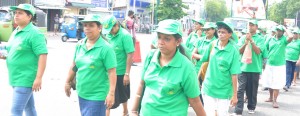Sunday Times 2
Why do we need a quota for women in Parliament?
View(s):Women’s representation in elected political bodies in Sri Lanka is among the lowest in the world. Yet the discussion and the debate around the electoral reforms or the 20th Amendment to the Constitution fail to address this issue by making provision for a quota for women in the new electoral system. I and many others have long argued that quotas represent the only way in which to address the abysmal numbers of women in elected political bodies in Sri Lanka. Here I wish to repeat these arguments in the hope that an opportunity to address this problem is not lost.

While most political parties have a women's wing and a substantial number of women members, they exist mainly to mobilise the female constituency in support of male candidates during elections. They do not function to increase women's representation.
A History of under-representation
Women in Sri Lanka gained the right to vote in 1931. In the post-independence period, Sri Lankan women made rapid progress in relation to health, education and employment, and their human development indicators are still considered a model for South Asia. However, women’s representation in elected political bodies has remained abysmally low. In parliament, the percentage of women has stagnated between 1.9 and 6.5 per cent. In provincial councils women’s representation has never exceeded 6 per cent. In local councils, the statistics are even more dismal, with women’s representation hovering between 1 and 2 per cent.
Major socio-political upheavals, including a civil war that lasted 30 years, a shift to neoliberal economic policies in 1977 and an electoral system based on proportional representation (PR) in 1988 have had no significant impact on the levels of representation of women in elected political bodies.
While there are a number of reasons for this, political parties have been amongst the biggest obstacles to advancing women’s representation. Their lack of internal democracy, the absence of women in the higher echelons of decision-making, the lack of support for women candidates and entrenched networks of patronage stretching from the national to local levels are among the major barriers to increasing women’s representation.
While most political parties in Sri Lanka have a women’s wing and substantial numbers of women members, these wings do not function to increase women’s representation. They are not autonomous and exist mainly to mobilise the female constituency in support of male candidates during elections. For women who are genuinely interested in politics, membership in women’s wings does not pave the way to mainstream politics and political leadership.
Nomination statistics speak for themselves. While the number of women candidates running for election has increased drastically since the introduction of PR, a closer look at these numbers reveals that this is due to fringe parties and independent groups, which seldom win, filling their lists with women. Major political parties with stronger electoral fortunes continue to fail to nominate women in any significant number. As a result, the overall increase in nominations has not translated into electoral gains for women. It is in this context that the demand for a quota for women in elected political bodies emerged in the late 1990s, clearly influenced by a global discourse on this question.
Quota for women
The core idea behind quotas and reservations is to remedy the historical imbalance in the numbers of women in political institutions. Women’s organisations and activists who advocate for quotas see them primarily as representing a shift from a formal to a substantial form of equality. The formal model of equality aims to achieve fairness by treating all individuals the same way. Expressed in the formulation “all person are equal before the law and have equal protection of the law”, it ignores attributes of sex, race, culture, class, etc., in formulating laws and policies. While formal equality can be a big improvement over traditional rules that often treat women much worse than men, sometimes it is simply not enough. If women have been systematically disadvantaged due to certain social, economic or cultural conditions, or discriminated against in a particular way, then treating them the same as men will end up keeping them unequal.
This is why a substantive model of equality is necessary. Underlying the demand for quotas for women in political institutions is the conviction that women’s under-representation in these institutions, almost an universal phenomenon, is neither natural nor just, but a result of structural discrimination that can only be remedied by “an exogenous shock”. Thus in a substantive model of equality, quotas are seen as fulfilling the demands of equality rather than creating an exception to it.
More than 100 countries to date have adopted some sort of quota for women, in what is being described as “a global phenomenon”, and “a remarkable achievement of the women’s movement”. These quotas have taken different forms, from voluntary or mandatory party quotas in nomination lists, to constitutionally or legally mandated reservation of seats. In the 60 years between 1930 and 1990, only 22 countries established quotas, but in the 1990s quotas for women appeared in more than 50 states, joined by nearly 40 more since 2000. Currently, parliamentary quotas for women are in place in a number of countries, including Rwanda, Afghanistan, Bangladesh, East Timor, Brazil, Bolivia, France and Pakistan. The percentage of seats/nominations allocated for women through these measures ranges from 10 to 50 per cent, while the standard is to ensure at least 30 per cent of seats for women, considered to be the “critical mass” that is necessary for transformational change.
Chulani Kodikara is a Senior Researcher at the International Centre for Ethnic Studies. Her research straddles issues at the intersection of law, feminism, gender and identity politics. She is the author of Muslim Family Law in Sri Lanka (1997), Women and Governance in Sri Lanka (2002, co-authored with Kishali Pinto Jayawardena), and Only until the Rice is Cooked? The Domestic Violence Act, Familial Ideology and Cultural Narratives in Sri Lanka (2012).

